
| Cathy's Traditional Bargello Patterns Page |
Last updated/links verified 11 February 2004 |
Cathy Decker's Bargello Needlework Page |
 |
| The Pomegrante Pattern | |
 William's Pomegrante Pattern | What Books Discuss the Pomegranate?Elsa S. Williams, Bargello: Florentine Canvas Work. (New York: Reinhold, 1967). [It's out of print, but you can order it here from Amazon.com.] The image to the right is from William's book on page forty-four. Williams writes, "One of the oldest patterns, this is frequently found in Early American collections. It has been used for purses, pillows, and chair seats" (44). William's version is interesting because it creates the effect of depth, much like the goal of the popular "Deep Boxes" pattern. (See the Geometric Patterns Page for "Deep Boxes.") |
| Pauline Fischer and Anabel Lasker, Bargello Magic: How to Design Your Own. (New York: Hold, Rinehart, and Winston, 1972) shows four variations on this pattern (see pages 46 and 84). [It's out of print, but you can order it here from Amazon.com.] Fischer and Lasker consider this pattern one for beginners. This is the first pattern I ever worked, using one Fischer and Lasker's versions. I did mine in shades of yellow with a green and maroon bottom or pit. I did mine on ten-count plastic canvas. As a novice, I didn't realize that plastic canvas was declassé, and that much of the cheap yarn I used would pill (or spoil) too easilty. You can see my piece below. Fischer and Lasker also have a variation of pomegranate in a four-way pattern called "Blue Cymbidium" (page 119); this version is concerned advanced. Margaret Boyles, Bargello: An Explosion in Color. (New York: Macmillan, 1974. [It's out of print, but you can order it here from Amazon.com.] Boyles considers this pattern a little more difficult, labelling it average not easy. She includes two variations of it (see pages 82-86). A Golden Hands Pattern Book: Bargello. (New York: Random House, 1972). [It's also out of print, but you can order it here from Amazon.com.] This book features a classic pattern and some interesting variations used to make purses (see pages 16-7, 50-1). | |
 Carroll's Pomegrante Pattern | Amy Carroll, ed., The Pattern Library: Needlepoint. (New York: Ballantine, 1981). This book features a rather flat, squarish version of pomegranate on page eighty-one.[Again, it's out of print, but you can order it here from Amazon.com.] |
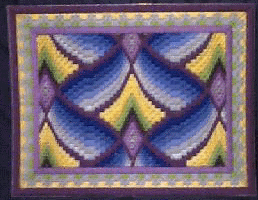 This is not exactly the variation discussed, but similar. Here the pomogranate is sort of split or merged at the "diamond" part of the pattern. | Consider the pomegranate in two parts, a diamond which is the base and an inverted heart. The divide the heart into two. Work the right side of the heart in six shades of one color and the left in six shades of another. Reverse this order on the pomegranates above and below and on the sides. The effect is two ribbons twisting down that have opposite colors on the other side. It's hard to visualize, but try to see the heart parts as two ribbons on any of these images, then imagine the coloring ... |

My First Bargello, a Classic Pomegranate Pattern | |
 An Original Pomegranate Pattern by Cathy | |
| This pattern is a weird mix of pomegranates in worked in two sets of colors and triangular edges that overlap on one side and only partially overlap on the other. The border is steel-blue rug yarn worked over 4 threads. This is done in 7-count on plastic canvas as well. | |
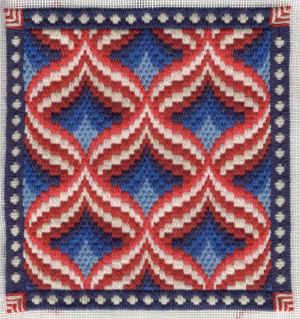 |
This variation on the pomegranate pattern is done in patriotic colors. The pattern is availble on the web, called American Ribbons 2001 Bargello Pattern. |
| The Carnation Pattern | |
| The carnation pattern was worked in the past on very high thread-count-per-inch fabric, probably linen. You can buy linen in 32 threads per inch, which looks about right for some of the old pieces pictured here. The modern versions are usually less detailed and compacted for adoption to thread counts of 14 to 18. | |
What Books Discuss the Carnation? | |
 Carnation Panel, c. 1700- 1750 Image copyright of Victoria and Albert Museum | |
| Donald King and Santina Levey. The Victoria and Albert Museum's Textile Collection: Embroidery in Britain From 1200 to 1750. (New York: Abbeville, 1993). [This book is in print and available!] This book doesn't actually discuss the pattern but has two examples, a 1718 silk hand screen (plate 122, page 108, #T.93-1934) and a panel labelled "Carnations in a compartmented ground" dated to the first part of the 18th century (plate 123, page 108, #T.178-1925). The brief descriptions are on page thirty. The former example is in the abstract style, like mine below, and the later combines realistic carnations and abstract ones. When carnations are more abstract, they are often called "Fused Diamonds" or some other name. You can see the latter above and the former below. | |
 Detail of Silk Carnation Hand Screen, 1718 Image copyright of Victoria and Albert Museum | |
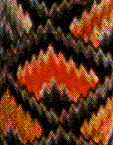 Detail of Chair Worked in Carnation Image Copyright of the Metropolitan Museum of Art. | A Golden Hands Pattern Book: Bargello. (New York: Random House, 1972). [It's out of print, but you can order it here from Amazon.com.] This book also features pictures of historical textiles worked in carnation; one is a signed wallet or pocketbook dated 1761 held by the Musuem of the City of New York. Another is an undated pocketbook from the Metropolitan Museum of Art. Both are more of the abstract type. There is also a slightly less abstract chair from the Met, pictures of which are on this page. The book also gives details on how to stitch three variations of carnation, one called "Prickly Pine," one called "Carnations," and one called, "Dress up a Waste-Paper Basket" (see pages 26-7, 44-5). The one called "Carnations" is the most flower-like. You can see these images below. |
  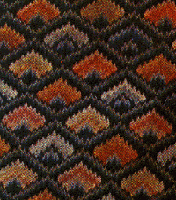 From left to right: "Carnations," "Prickly Pine," and Detail of the Met's Carnation Chair | |
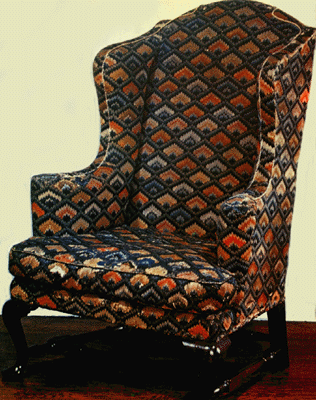 The Met's Carnation Chair Image copyright of the Metropolitan Museum of Art. (I don't have this pattern, unfortunately) | |
Elsa S. Williams, Bargello: Florentine Canvas Work. (New York: Reinhold, 1967). [It's out of print, but you can order it here from Amazon.com.] Williams adapted "an original piece at The Embroiderers' Guild, London England" for her "Traditional Carnations" (63). She also has an abstract version of the pattern that she calls "Fused Diamonds" (43). Bargello Magic: How to Design Your Own. (New York: Hold, Rinehart, and Winston, 1972) shows ten variations on this pattern, all abstract and all called "Fused Diamonds" (see pages 50-69). [This book is out of print, but you can order it here from Amazon.com. By the way, it's great.] Variations 2 and 3 are actually colored to look like carnations. Variations 1 and 4 are in the abstract tradition. The other six designs are really not traditional carnation at all. Margaret Boyles, Bargello: An Explosion in Color. (New York: Macmillan, 1974. [It's out of print, but you can order it here from Amazon.com.] This book features two lovely carnation patterns, rated "average" in difficulty (pages 90-91). | |
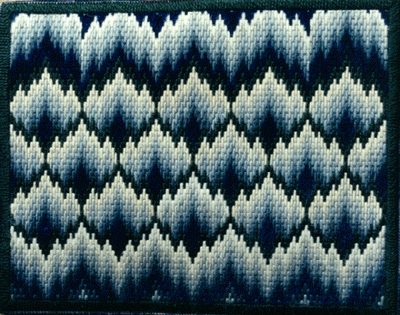
The center is a tradition carnation pattern of the more abstract type.This variation is an orignal design of my own. This image has some color problems--the trim is a brighter green and the purples are much richer. Someday I'll have to rephotograph this! |
|
| This pattern is a simple frame of one row of stitches around what is basically a carnation pattern. The top and bottom of the pattern is basically taking the edge of the carnation frame and repeating it. However for variation, at times at the top of the piece, the rows break colors at key vertical lines, so the effect is more of a shifting one. This is worked in tapestry wool and purple chenille over ten-count canvas. I've seen many early American 18th-century versions of this--some called oldly, "Irish Work." Usually the early American versions are worked with a great number of stitches per inch in very bright, bold colors of multiple hues. I chose greys and purples, which make this a pretty somber pillow. I worked a lot of this while staying with a friend in intensive care, so perhaps that is why it came out a bit "dark" in tone. | |
"American Medallions Bargello," a traditional-style Carnation pattern variation. | |
| This is not my own work, nor is it historical. It is a piece called "American Medallions Bargello," a pattern formally available on the web. "Medallions" are usually formed by flipping a frame-based pattern at the horizontal center of the canvas. The frame that is usually filled in with the same design then forms a larger shape and is usually filled in a unique way. Two colors of carnations are varied in this piece, a red and a pink. Here the traditional-style pink carnation is at the center line and forms an interesting medallion. By the way, I don't have the pattern for this, and it doesn't seem available on the web any more unfortunately. | |